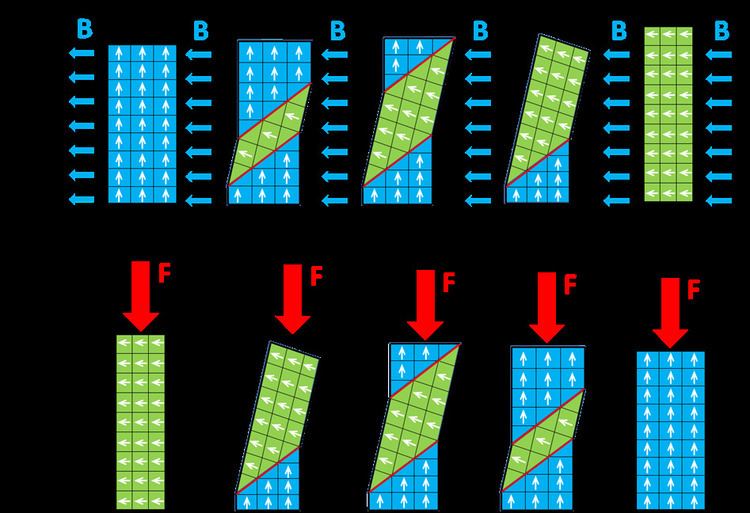 | ||
Magnetic shape memory alloys (MSMAs), also called ferromagnetic shape memory alloys (FSMA), are particular shape memory alloys which produce forces and deformations in response to a magnetic field. The thermal shape memory effect has been obtained in these materials, too.
Contents
Introduction
MSM alloys are ferromagnetic materials that can produce motion and forces under moderate magnetic fields. Typically, MSMAs are alloys of Nickel, Manganese and Gallium (Ni-Mn-Ga).
A magnetically induced deformation of about 0.2% was presented in 1996 by Dr. Kari Ullakko and co-workers at MIT. Since then, improvements on the production process and on the subsequent treatment of the alloys have led to deformations of up to 6% for commercially-available single crystalline Ni-Mn-Ga MSM elements, as well as up to 10-12 % and 20% for new alloys in R&D stage.
The large magnetically induced strain, as well as the short response times make the MSM technology very attractive for the design of innovative actuators to be used in pneumatics, robotics, medical devices and mechatronics. MSM alloys change their magnetic properties depending on the deformation. This companion effect, which co-exist with the actuation, can be useful for the design of displacement, speed or force sensors and mechanical energy harvesters.
The magnetic shape memory effect occurs in the low temperature martensite phase of the alloy, where the elementary cells composing the alloy have tetragonal geometry. If the temperature is increased beyond the martensite–austenite transformation temperature, the alloy goes to the austenite phase where the elementary cells have cubic geometry. With such geometry the magnetic shape memory effect is lost.
The transition from martensite to austenite produces force and deformation. Therefore, MSM alloys can be also activated thermally, like thermal shape memory alloys (see, for instance, Nickel-Titanium (Ni-Ti) alloys).
The magnetic shape memory effect
The mechanism responsible for the large strain of MSM alloys is the so-called magnetically induced reorientation (MIR), and is sketched in the figure. Like other ferromagnetic materials, MSM alloys exhibit a macroscopic magnetization when subjected to an external magnetic field, emerging from the alignment of elementary magnetizations along the field direction. However, differently from standard ferromagnetic materials, the alignment is obtained by the geometric rotation of the elementary cells composing the alloy, and not by rotation of the magnetization vectors within the cells (like in magnetostriction).
A similar phenomenon occurs when the alloy is subjected to an external force. Macroscopically, the force acts like the magnetic field, favoring the rotation of the elementary cells and achieving elongation or contraction depending on its application within the reference coordinate system. The elongation and contraction processes are shown in the figure where, for example, the elongation is achieved magnetically and the contraction mechanically.
The rotation of the cells is a consequence of the large magnetic anisotropy of MSM alloys, and the high mobility of the internal regions. Simply speaking, an MSM element is composed by internal regions, each having a different orientation of the elementary cells (the regions are shown by the figure in green and blue colors). These regions are called twin-variants. The application of a magnetic field or of an external stress shifts the boundaries of the variants, called twin boundaries, and thus favors one variant or the other. When the element is completely contracted or completely elongated, it is formed by only one variant and it is said to be in a single variant state. The magnetization of the MSM element along a fixed direction differs if the element is in the contraction or in the elongation single variant state. The magnetic anisotropy is the difference between the energy required to magnetize the element in contraction single variant state and in elongation single variant state. The value of the anisotropy is related to the maximum work-output of the MSM alloy, and thus to the available strain and force that can be used for applications.
Properties
The main properties of the MSM effect for commercially available elements are summarized in (where other aspects of the technology and of the related applications are described):
Development of the alloys
Standard alloys are Nickel-Manganese-Gallium (Ni-Mn-Ga) alloys, which are investigated since the first relevant MSM effect has been published in 1996. Other alloys under investigation are Iron-Palladium (Fe-Pd) alloys, Nickel-Iron-Gallium (Ni-Fe-Ga) alloys, and several derivates of the basic Ni-Mn-Ga alloy which further contain Iron (Fe), Cobalt (Co) or Copper (Cu). The main motivation behind the continuous development and testing of new alloys is to achieve improved thermo-magneto-mechanical properties, such as a lower internal friction, a higher transformation temperature and a higher Curie temperature, which would allow the use of MSM alloys in several applications. In fact, the actual temperature range of standard alloys is up to 50 °C. Recently, a 80 °C alloy has been presented.
Applications
MSM actuator elements can be used where fast and precise motion is required. Possible application fields are robotics, manufacturing, medical surgery, valves, dampers, sorting.
